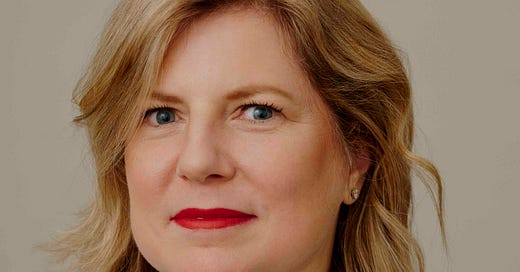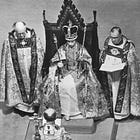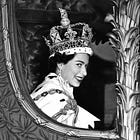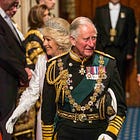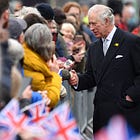Elizabeth Angell on the Moment ‘the Royal Family Presents Itself Officially to Us’
The American editor who has spent more than two decades covering the Windsors has some questions about the coronation.
Hello from London! I arrived on Tuesday, dropped my bags, and headed straight for Buckingham Palace to survey the crowd. In chatting with folks milling about out front of the extra-shiny Queen Victoria Memorial, I sensed a curiosity for the coronation rather than full-blown enthusiasm. It’s early in the week, to be sure, and I expect the excitement to build as the week goes on. But the energy for the crowning of King Charles III — as of yet — is nowhere near that of the late queen’s Platinum Jubilee last year, when the city was vibrating with a celebratory spirit.
The atmosphere, and yours truly, got a significant jolt when the king pulled up to the palace. It was a reminder that there’s nothing quite as powerful as a royal being seen.
As we continue to think through the charged topic of a coronation, I’m thrilled to bring you another guest essay by a woman I admire. Elizabeth Angell now runs my favorite parenting website, Romper. I was lucky enough to write for her back when she was executive digital director of Town & Country, where she made the site into a must-read on the British Royal Family. Elizabeth is also tops on my list of people to text when major royal news breaks — I always want to get her take.
Below is her piece on living in Paris in August 1997, what it was like to drive coverage of the Windsors in turbulent times, and the questions she has for May 6 and beyond.
PS: There are 20 (!) SMT gatherings planned to watch or discuss the coronation, with groups getting together in Atlanta, Seattle, New York, Chicago, and more. For the full list, as well as how to join a group, click here.
The So Many Thoughts Coronation Podcast
Click below to listen to a look back at the history of coronations, a preview of King Charles III’s crowning, and my conversations with royal writers and watchers about this complex moment in royal history. (Episode 3 is free for all!)
Check out these instructions for how to listen to the SMT podcast on your phone via your favorite podcast app.
Elizabeth Angell on the Moment ‘the Royal Family Presents Itself Officially to Us’
I have several garlands worth of Union Jack bunting sitting in an Etsy cart, waiting for me to check out. I am trying to decide if I should throw a coronation watch party. Would anybody come to my house at 5 a.m. on a Saturday to watch this particular bit of British royal pageantry? Can I find clotted cream in Brooklyn? Will I look unhinged throwing a party to celebrate the accession to the throne of a 74-year-old man whose name elicits a near-universal shrug and nose wrinkle? (As in: “I guess he’s King Charles now?”)
I probably don’t have to worry too much about being judged. By now my friends and loved ones are well aware of my fascination with the British royal family. People have asked me if I’m a monarchist. They assume my enthusiasm for royal minutiae means I am a Windsor partisan. I am quick to tell them that I do not care — not in that way. I’m not on anyone’s side. I am an American; if I had to choose, I’d rather live in a mansion in Montecito than a drafty bedroom in Buckingham Palace. I was born in a country that threw off the yoke of King George’s tyranny two and a half centuries ago, and so I am free to amass trivia, to ogle the ill-gotten jewels, and to watch this self-conscious transmission of history without worrying that I might one day have to vote on its legitimacy in the 21st century.
I suspect many of the people who are having a hard time getting excited about the coronation of a male queen (in this day and age!) found their way to royal watching through a wedding or the arrival of a new prince or princess. Fair enough, but my interest in the Windsors wasn’t launched by a “fairy tale” wedding or the birth of a baby; I was hooked by a tragedy. My first job after college was working for two journalists writing a book about Princess Diana’s accident and death; for months I researched the Windsors and Spencers and Al Fayeds. I was living in Paris in August 1997 and I watched as the city — and then the world — came to a halt in the dog days of summer to scream its grief at the death of a charismatic, beautiful, sad woman. Mother Theresa died the same week. Why did a literal saint not elicit anything like the same kind of collective outpouring?
It wasn’t just that people were affected by Diana’s death. It seemed to amplify their own losses, their own feelings about neglectful, unfaithful husbands, and chilly in-laws, and old-fashioned institutions that had made them feel patronized and snubbed one too many times. I’ve been an anglophile and history lover my whole life, but it wasn’t the facade of Kensington palace that drew me in. It was the austere gates piled high with wilting flowers and teddy bears and candles and weeping men and women. Everything the Windsor family and the Royal Firm has done since August 1997 has been to atone, apologize, and try to eclipse that terrible week.
As a journalist, I’ve covered the royal family for more than two decades, and it’s given me an excuse to indulge my curiosity. From 2016 to 2020 I was the Executive Digital Editor at Town & Country and together with my brilliant colleagues (in particular Caroline Hallemann) we built a reputation for thorough, even-handed coverage of the British Royal Family. We saw it as our job to answer questions about who these people were and why they were doing what they were doing. It was a straightforward mission at a time when other digital outlets were aggregating and amplifying every rumor, regardless of its source, and reducing “royal protocol” to questions of nail color and nude pantyhose. It occasionally seemed silly (really, who cares what nail polish Kate wore) but by the time Meghan Markle became the Duchess of Sussex, that mission had taken on a profound urgency. It mattered what people knew and understood about things like “royal protocol,” because so many misinformed people were slinging lies about this transformative new member of the family. Those lies — and the heightened emotions this family seems to bring out — were snowballing.
We all know how that turned out.
For an institution that is supposed to change at a glacial, imperceptible pace — above the fray but not out-of-step with the times — the last few years have been a slushy, dizzying, messy transformation. The Windsors (and the machine that keeps them afloat) have not reacted with particular grace to much of that change, so I watch the big, meticulously-planned events with special interest. These are the moments when the royal family presents itself officially to us, tells us what it values (at least outwardly) and accounts for its flaws and past sins (or fails to do so). Queen Elizabeth had 70 years to establish herself as a steadfast, cautious, loyal figurehead, an icon of Britishness who somehow maintained her aloof relevance from Empire to Brexit. King Charles has much less time. What will he want us to know about Britishness in his time? How will he set up his son William to do that again in a relatively short time?
Unlike the Windsor family weddings and funerals that we’ve seen in the last few decades, whose purpose was immediately clear and for which we had our own personal reference points to compare them with, this strange event will be unlike anything most of us have ever seen. There will be scepters and orbs, stones of destiny (yes really) and anointing with oil. There will be talk of sacred duty.
And unlike weddings and funerals, which are at least in part for the family, I believe that coronations do not count if they are not witnessed in some way or another by people. The Archbishop of Canterbury and King Charles might see it differently, but as far as I’m concerned, this thing is for us, the viewing public, to usher us all into the next phase of this institution. It’s a living link — not just to the many British monarchs that have come before, but to the people who have watched coronations from roadsides in London for a millennia. And if you watch this one, you’ll be able to see how William and Kate change the ceremony when it’s their turn, because despite what the Palace might have you believe, there is nothing fixed or even all that ancient about this ritual — it is constantly evolving.
I’ll be looking for all that on May 6. And gleefully tracking all the European royalty who make their way to Westminster Abbey (you didn’t think my enthusiasm for princesses and aristocrats ended with the Windsors, did you?). Ask me questions about the Greek royals and their strange half exile, a parable about modern Greek identity (and Duty Free wealth) if ever there was one. What about the Casiraghis or Crown Princess Mette-Marit? All have fascinating, very modern stories caught up in ancient families. And they wear really good clothes.
And I’ll have my eyes peeled for the Black Prince’s Ruby. It’s a gigantic, bright red knob of a gem (though it’s not actually a ruby, but an uncut, deep red, 170-carat spinel). It once belonged to Sultan Muhammad VI of Granada and entered the British Crown Jewels in the 14th century. It was on the jewel-encrusted that King Henry V wore into battle at Agincourt on October 25, 1415. Ordinarily you can visit it in the Tower of London, where it lives, embedded in the front of the Imperial State Crown. But on the first Saturday in May, it will be placed on King Charles’s head during the coronation ceremony.
Tell me you don’t want to see that.
Thank you so much, Elizabeth! You can find her on Instagram here and check out the award-winning parenting coverage she runs at Romper.
And stay tuned! Episode 5 of the So Many Thoughts Coronation Podcast drops later today, featuring my conversations with Elizabeth and Ateh Jewel (read her essay here) as well as Adebola Olayinka and Britt Stephens. I’ll email it out to paid subscribers, make sure you are signed up so it arrives in your inbox. 📥

